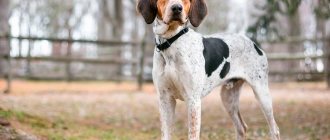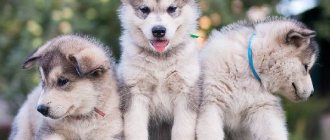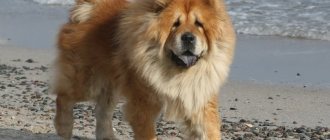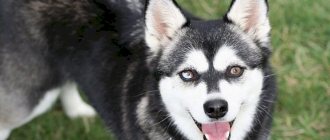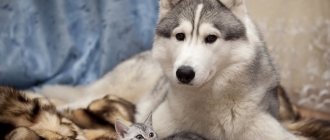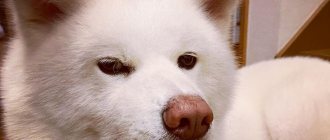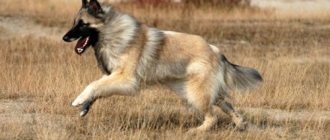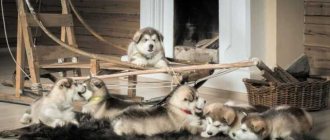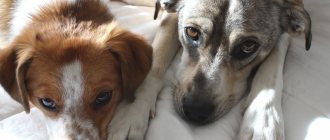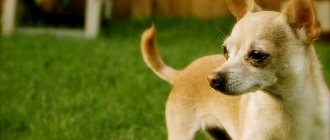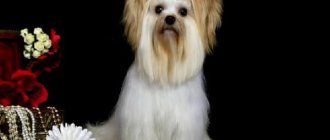The Alaskan Malamute is highly prized in the north. In northern latitudes it is used as a sled dog. An adult Alaskan Malamute dog is distinguished by sociability, endurance, large size, ability to work and a strong character, which is incredibly combined with friendliness.
Representatives of the oldest breed, walking with their owner, become the center of attention and arouse the admiration of others. They are often confused with cheerful and cheerful huskies. However, there is still a difference between the Alaskan Malamute and the Husky.
The main features of these wonderful dogs are strong limbs and great drafting ability. But it is their pretty appearance that makes Malamutes everyone’s favorite.
Where did Alaskan Malamutes come from?
The Alaskan Malamute dog is not only in great demand among northern peoples, but is also one of the oldest North American breeds. In addition, it is considered one of the most ancient on earth. There are suggestions that Alaskan Malamutes have lived alongside people since Paleolithic times. They are confirmed by archaeological finds, proving the fact that Malamutes have remained virtually unchanged since that time. In 2004, geneticists analyzed the DNA of dogs and determined their significant similarity to the wolf. This discovery suggests that Malamutes are simply domesticated wolves. They came to North America along with their owners about fourteen thousand years ago.
In addition to the resemblance to a wolf, some other interesting facts were discovered. Their DNA was found to be similar to the Alaskan Klee Kai and Husky. But Malamutes differ from the latter in size and weight. They have a heavier skeleton and powerful build. The weight of an Alaskan Malamute ranges from 34 to 39 kilograms, while the largest Husky weighs no more than 27 kilograms.
Hunters and guards
Malamutes were not immediately involved in cargo transportation. In ancient times, Eskimos roamed the northern territories, trying to find food and conditions suitable for life. Dogs also wandered with them, helping the men in hunting and protecting the tribe. They received such characteristics of the Alaskan Malamute breed, which are inherent in modern dogs, from their ancestors. Harsh climatic conditions and a limited amount of food made the animals strong and resilient. Weak individuals simply did not survive, falling out of the genetic chain to give way to the strong and fit.
For several centuries, the development of the breed took place on the territory of the Anvik River. The Eskimos of the Malemute tribe, who came to Alaska from Siberia, began to settle here. The tribe raised dogs to their own standards. Animals weren't supposed to be beautiful. The main characteristics of Alaskan Malamutes were strength, frost resistance, the ability to hunt and carry loads. Thanks to natural and human selection, animals have become what we know them today.
Malamutes in Europe
Over time, the Alaskan Malamute breed became popular in Europe. Domestic wolves appeared in Europe at the end of the 19th century, although people had heard about them for a very long time. The gold rush contributed to its popularity. It was thanks to her that in 1896 people who wanted to get rich began to flock to the Klondike. And since movement in the northern area was difficult, the “help” of the Malamutes was needed. Due to the demand for these dogs, their prices have skyrocketed. For one individual they asked for 500 dollars, and for a team of 1500 thousand. Thus, furry giants became the most expensive and sought-after animals in the northern territories.
Then gold miners brought other breeds with them, trying to cross them with Malamutes. But their attempts to breed strong and resilient dogs were unsuccessful. The puppies turned out to be beautiful, but aggressive and quarrelsome. In addition, their driving characteristics were poor. Therefore, they refused to cross them with St. Bernards and Newfoundlands.
Rescue from extinction
The most important quality of Alaskan Malamutes is their endurance. However, their ability to adapt to climatic conditions and work in a team is significantly inferior to dogs of other breeds, as well as speed characteristics. To improve these data, breeders have tried to cross Malamutes with smaller breeds. As a result of such experiments, dogs almost completely disappeared. Enthusiastic breeders helped to avoid this disaster and restored the breed.
After the threat of extinction of the dogs had passed, over the next twenty years the breed was divided into three lines. These were Hinvan-Irwin, M'Luth and Kotzebue. Representatives of these lines are the ancestors of modern Alaskan Malamutes, which retain the features of one line or another.
Official symbol of Alaska
Due to World War II, the Alaskan Malamute was once again endangered. In 1947, there were only 30 purebred individuals left. To save the breed from extinction, breeders had to deviate from the usual standards and established breed lines. However, such sacrifices still bore fruit. Malamutes were not only preserved, but also made one of the most popular dog breeds.
In the distant past, Alaskan Malamutes were ordinary sled dogs, but now they have become one of the official symbols of Alaska. However, despite the high status of the breed, efficient and hardy dogs in the northern regions continue to be used for transporting heavy loads.
Varieties
At the moment, there are two lines of Alaskan Malamutes, which, albeit insignificantly, still differ from each other. First of all, in size. But there are other differences, which the table will tell you about.
Table - Characteristic differences between Malamutes of the M'Lut and Kotzebue lines
| Characteristics | M'Luth | Kotzebue |
| Height at withers, cm | Up to 63 | Up to 60 |
| Weight, kg | 38 | 36 |
| Aggressiveness | + | — |
| Color | - White; — black and white; - brown-white; - sable; - red and white | Wolf |
Breeders are still arguing about who is better - representatives of the M'Luth or Kotzebue line. But as long as none of the varieties has lost its original functions and working qualities, this dispute will be meaningless and endless.
Features and external data of the breed
If we study in detail the description of the Alaskan Malamute, we will see that it is a large, strong and beautiful dog, which has an extraordinary resemblance to a wolf. In addition to its spectacular appearance, the dog stands out for its irrepressible energy, which not all owners can cope with. Despite the fact that dogs are good-natured towards people, they prefer to dominate them.
If in everyday life the independent character of the Alaskan Malamute is not very pleasing to the owners, then in extreme situations this feature is a big plus. Dogs are able to make their own decisions and save their lives and the lives of their owners in dangerous situations.
In Russia, for a long time, Malamutes were something exotic. However, now the breed has a large number of fans. True, often this admiration for a dog begins to fade as it grows up, because if it is raised incorrectly, it becomes uncontrollable.
This is not the animal's fault. It is the people themselves who are to blame for buying a handsome fluffy dog, hoping that he will grow up obedient and flexible. Without proper education, training and care, it will not be possible to raise a worthy family member. Therefore, if a person is not going to devote a large amount of time to the dog and does not consider it necessary to take into account the dog’s character traits, he should refuse to buy a Malamute.
However, if the future owner of a pet wolf begins to take care of the puppy from the first days, trains it according to the advice of dog handlers, cares for it and devotes the necessary amount of time, then he will not only raise an excellent dog, but also a true faithful friend who understands him at a glance.
Appearance and features inherent in Malamutes
The Alaskan Malamute has a strong build, a muscular body and a dense, thick coat. Representatives of the breed are distinguished by a large head and deep chest, so even female Malamutes have a rather impressive appearance. But looking at the puppies that look like cute teddy bears, it’s hard to believe that in the future they will turn into huge, energetic dogs.
Although dogs have a large skull, it is not heavy. The muzzle is large compared to the black box. The stop is not sharp, but quite noticeable. Dogs have wide jaws with large teeth. A correct bite should be a scissor bite.
Malamutes have almond-shaped, medium-sized, brown eyes. If the iris is blue, then this is considered a disqualifying defect. Dogs have medium, triangular ears. The nose is large with wide nostrils and a black nose.
The neck is powerful and strong. The body is massive with strong bones. The tail is straight, fluffy, raised above the back. The forelimbs have developed muscles and are massive. The paw pads are large, collected, developed with tightly closed toes and protective hair between them. The hind legs are also strong and massive. They are located in line with the front ones.
Malamutes have a double coat. The first type of coat is guard and hard, and the second is soft and dense. In winter, dogs have long hair, and in summer it is shorter and not as thick.
The colors of Alaskan Malamutes are few. The most common is the wolf one. Also, representatives of the breed can be black, gray, white and sable. Colors can be combined. But this is only permissible in the undercoat and underpants area. Color combinations elsewhere are not permitted. The white color is more in the lower part of the body, on the paws and face in the form of a mask. A white spot on the forehead and a stripe on the back of the neck are allowed.
"Important! The color of Alaskan Malamutes is called mantle, this eliminates the presence of both uneven color and spots that break it.”
Possible disadvantages
Any deficiencies and pathologies of a dog’s limbs are considered serious defects. In Malamutes they are represented by a cow-like set of hind legs, their spacing, weak pasterns, straight shoulder girdle or insufficient angles.
Also defects are stilted or other types of movements, incorrect proportions, too powerful or, conversely, a slender physique.
Disqualifying faults
These include blue irises or other obvious physical abnormalities. Mental symptoms include cowardice or increased aggression. Also a defect will be cryptorchidism detected in a male dog.
Possible defects
The main task of Alaskan Malamutes is to transport heavy loads, which requires ideal paw condition.
Any deviations in the shape of the limbs that affect the manner of movement or stance are usually regarded as a developmental pathology. The most common defects are:
- Straight shoulders.
- Weak pasterns.
- Widely spaced hindquarters.
- Insufficiently developed muscles.
- Excessive weight.
- Weak bones.
- Body disproportion.
A movement pattern that differs from that prescribed in the standard is considered insufficiently effective and is therefore also considered a breed defect.
The definition of an identified deviation from the standard as a defect depends on how pronounced it is and how capable it is of affecting the health of the individual as it grows. Disqualifying faults
The basis for culling an individual is considered to be the presence of physical characteristics that do not meet the standard. A male dog can also be disqualified if it is discovered that he has underdeveloped testes or undescended testicles into the scrotum. Dogs that show excessive aggression towards other animals, humans, or experience paralyzing fear when placed in an unfamiliar situation are subject to culling.
Character of Alaskan Malamutes
This is just a photo of an Alaskan Malamute, calm and peaceful. In life, things are far from being like that. These dogs are not lazy and cannot be classified as couch potatoes. They are very energetic and require constant attention from their owner. Many people believe that a long walk will force the pet to come home and go to bed. No. He will run around the apartment like crazy and continue to chew furniture and do other indecent things. Living in a private house, the dog will dig huge holes in the yard and try to jump over even the highest fence. The dog's irrepressible energy is to blame. For the first three years you will have to work hard and train her. You will need to take long walks with your pet and learn the rules of good manners. You should not expect the dog to become calm; its remarkable energy will decrease slightly only after three years.
Malamutes are similar to a wolf not only in appearance, but also in their habits. That's why they are bad defenders. Dogs cannot bark, but they howl beautifully, and they love it. These fluffy beauties are distinguished by their good nature and sociability. However, if they are not raised correctly, these qualities will turn into uncontrollability and constant attempts to dominate the family. The dog must clearly understand that he is a pet, not an owner, otherwise there will be big problems with him.
Fluffy handsome men with gangster habits
Despite its playful character, the Alaskan Malamute has an excellent memory. Therefore, domestic wolves must be treated with due respect, since they remember bad treatment well and can, on occasion, take revenge for it.
Entertainment for dogs is unique. If they get tired of the routine, they will start rushing around the yard, house or apartment, demolishing everything that gets in their way. They do not like confined spaces, so you should not keep such dogs in an apartment. A spacious enclosure and a large yard will suit them. In addition, you should walk with them for several hours every day. It is better not to leave other animals and small children alone with the dog. She is large and very playful, so she can accidentally injure those who are smaller and weaker than her.
Educational moments and training of Alaskan Malamutes
Malamutes are characterized by intelligence and mobility from birth. Malamute puppies try to become leaders even in early childhood. Therefore, the owner must show consistency and firmness in raising the baby. Physical activity should be increased as you grow older. It is necessary to train an Alaskan Malamute puppy immediately after purchase. First of all, he needs to be taught neatness and his own name.
The dog should also be socialized. You can start visiting the training ground at four months. There she can not only learn new commands, but also find playmates. In addition, she will learn to react calmly to cars and extraneous sounds, thus strengthening her nervous system and learning to live in a metropolis.
Nicknames for dogs
The dog must respond to its name, this is also one of the commands. The nickname should be short and easy to pronounce, so the pet will remember it easier. Choosing a name for an Alaskan Malamute should be approached with all responsibility. Experienced dog handlers advise:
- When choosing a nickname, you should take into account the size of the pet. A diminutive for a big dog sounds ridiculous.
- Malamutes can be called by color: Sable, Red, Black.
- The nickname can reflect the harsh natural conditions in which the Malamute lives: Hurricane, Snowball, Buran.
- Nicknames for boys can be borrowed from films, toponymic terms: Viking, Oscar, Brutus, Kazbek, Nord, Danube.
- Nicknames for girls are usually chosen so that there are two syllables that go well together: Dina, Eva, Lizzie, Rada, Nora.
The name of an animal cannot be changed at will. It is given once and for all.
Maintenance and care
Since Alaskan Malamutes have a very thick coat, they can be kept outdoors all year round and are not afraid of frost. In summer it becomes more rare. To keep your pet's coat in good condition, it should be carefully looked after. The dog needs to be brushed every few weeks.
To prevent the dog from getting bored, tearing up furniture and digging trenches in the backyard, you need to walk him for several hours every day. This way, the dog will not only expend indefatigable reserves of energy, but can also maintain the necessary shape.
Malamutes cannot be considered gourmets; they can be fed natural food. Often their owners give their pets porridge with meat. However, you can give them dry food, but it must be suitable for this breed and belong to the premium class. Even if the dog consumes more food than it needs, it will not gain weight, since its lifestyle simply will not allow it.
Mating
According to experienced dog breeders, mating of Malamutes should occur when the male is 24 months old and the female is 20 months old. It is not recommended to breed dogs at a younger age, as this is a big burden for their fragile bodies. Knitting can be freestyle or manual. With freedom, the process occurs naturally. If the bitch is inexperienced, the dog owner helps them by first putting a muzzle on the bitch.
During pregnancy, physical stress on the bitch should be reduced. To give birth to puppies, you need to prepare a place for the dog and let her get used to it. At the moment when labor begins, you need to be close to the dog, distract it, and surround it with affection. Once the puppies arrive, it is best to leave the bitch alone. After the birth of the offspring, it is also better not to approach them at first. The mother should be allowed to feed and wash the puppies in peace. Then it will be possible to toilet the dog and examine the puppies.
Health of Alaskan Malamutes
The description of the breed indicates that the dogs are very hardy and have excellent health, but they are still susceptible to some diseases. Most often they develop a neurological disorder called polyneuropathy.
Dogs may also be diagnosed with hip problems. Malamutes also suffer from hemophilia, diabetes, dermatitis, anal adenocarcinoma and demodicosis.
As your pet ages, it can develop cataracts and glaucoma. Some representatives of the breed experience bloating and hypothyroidism. At the same time, Alaskan Malamutes are long-lived and with proper care can live up to 20 years.
Choosing a Malamute puppy
Before you buy an Alaskan Malamute, there are a few important rules to consider. To avoid possible risks, it is better to purchase a puppy from a kennel or registered breeders. Perhaps in this case the price of a Malamute puppy will be high, but the future owner will be able to be sure that he has acquired a purebred representative of the breed.
In addition to the pedigree, a small Alaskan Malamute must have documents from the RKF and SKOR. Club documents should not be trusted, since in the end the dog may turn out to be either not purebred or have defects.
A baby should be purchased between 1 and 4 months of age. Month-old puppies are taken by those owners who want the little Malamute to begin to get used to a new family from infancy. But if the future owner wants to see the makings of the exterior and character, then he should wait until the baby grows up a little.
Regardless of how old the puppy is, he should be active, cheerful and playful. Healthy Malamute puppies should look like little bears with dark eyes, thick paws and a tail. The color of the baby should match the color of the adult. The coat should be thick and fluffy. If a small Malamute has show potential, then in addition to its appearance it must have a daring and self-confident character.
To choose a child who will grow up balanced and have leadership abilities, you need to check him as follows. You should put a collar and leash on the puppy, and then call him to follow you. If he follows his future owner without any problems, then he will grow into a worthy and well-mannered Malamute.
The fate of the extinct Hinmann-Irwin (or Hinman-Irwing) line
Kayak Of Brookside , male, born approximately 1940
(Hinman's Alaska x Mayos Nome) The dogs of the Hinman-Irwin line had a significant influence on M'Luth, being completely absorbed into that line.
The Husky-Pak kennel, whose dogs were widely used in the breed, first infused their M'Loots with the blood of the Hinman-Irwin line, and then mated the resulting M'Loot offspring with a purebred Kotzebue male. Father M'Luth, mother Hinman-Irwin.
CH Spawn's Alaska , born 09/07/1946
(Koyuk x Kiska) - 2-time winner of Westminster in 1951 and 1953. He had a great influence on the breed through his descendants at the Husky-Pak nursery, where only 1 litter was obtained from him. Spawn's Alaska children:
| Male CH Apache Chief Of Husky-Pak , ROM, 06/07/1948 (CH Spawn's Alaska x Chitina 1) | Bitch CH Arctic Storm Of Husky-Pak , ROM, 06/07/1948 (CH Spawn's Alaska x Chitina 1) |
Malamute puppies cost
Those who are planning to buy a northern beauty are probably wondering how much an Alaskan Malamute costs? If the future owner is going to purchase an exhibition specimen, then the puppy will cost him around 100 thousand rubles. A small Malamute without documents will cost several times less and will cost about 15 thousand rubles. Such a huge difference in price is ensured by the fact that purebred puppies are suitable for breeding, and babies without a passport are purchased only for the soul.
The price of Alaskan Malamute puppies can also be influenced by the title of its parents. The more regalia they have, the more expensive their babies will be.
Interesting facts about Alaskan Malamutes
How did it happen that the breed of northern dogs became popular even where there is no trace of snow? This happened when they learned about Alaskan Malamutes in America, and it was thanks to the Americans that these amazing dogs spread throughout the world.
Why do these furry giants attract dog lovers so much? Let's get acquainted with interesting facts about Malamutes.
- Dogs of this breed starred in the famous film “White Captivity”.
- Malamutes are very hyperactive and simply love to dig in the ground, which is why they got the name shrews.
- Dogs cannot bark, but they love to howl. This quality was inherited from their ancestors.
- When you press on the pads of the paws, the claws of Malamutes come out, like those of cats.
- Dogs of this breed are excellent hunters and catch everything that moves.
- Malamutes do not grow up by one year, like ordinary dogs, but only by three years.
- Northern dogs do not like to swim and do not tolerate heat well.
As you can see, these are not only cute, fluffy giants, but also real descendants of the Arctic wolf, who have firmly entered the hearts of dog lovers and settled there forever.
